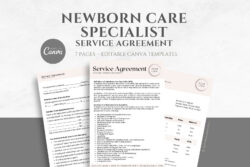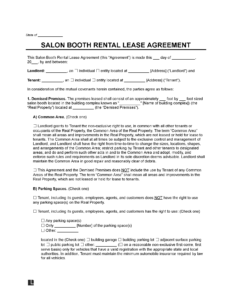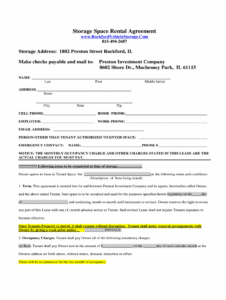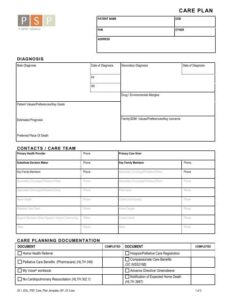Finding the right live-in caregiver for a loved one is a significant step, offering comfort and peace of mind. This arrangement provides continuous support within the home, allowing individuals to maintain their independence and familiar surroundings. However, such an important relationship, built on trust and daily interaction, thrives best when clearly defined from the outset.
That’s where a comprehensive agreement comes into play. It acts as a roadmap, setting clear expectations for both the caregiver and the care recipient’s family. Without a proper document, misunderstandings can arise, leading to potential disputes and stress for everyone involved. Establishing a transparent framework right from the beginning ensures a smoother, more professional, and ultimately, more harmonious caregiving experience.
What to Include in Your Live-In Caregiver Contract
Crafting a detailed live-in caregiver contract template is perhaps the most crucial step in establishing a professional and harmonious caregiving relationship. This document isn’t just a formality; it’s a foundation that protects both the caregiver and the care recipient, outlining responsibilities, compensation, and expectations. A well-written contract minimizes ambiguities, preventing future disagreements and ensuring everyone is on the same page from day one.
Think of it as laying out all the ground rules upfront. From daily tasks to emergency protocols, every significant aspect of the caregiving arrangement should be meticulously documented. This level of detail ensures that the caregiver understands their role completely and that the family has a clear understanding of the services provided, fostering a sense of security and professionalism for all parties.
Defining the Scope of Duties
One of the most important sections of any live-in caregiver contract template is a thorough description of the caregiver’s responsibilities. This needs to be as specific as possible to avoid any confusion.
- **Personal Care:** Assisting with bathing, dressing, grooming, toileting, and mobility.
- **Medication Management:** Reminding or assisting with medication intake, tracking dosages, and reporting side effects.
- **Meal Preparation:** Planning and preparing nutritious meals, considering dietary restrictions or preferences.
- **Household Tasks:** Light housekeeping, laundry, and maintaining a clean and safe living environment.
- **Companionship and Engagement:** Providing emotional support, engaging in conversations, accompanying on outings.
- **Transportation:** Driving to appointments, errands, or social activities, if applicable.
- **Communication:** Maintaining clear and consistent communication with family members regarding the care recipient’s well-being.
Compensation and Benefits
This section clearly outlines how the caregiver will be paid and any additional benefits they receive.
- **Hourly Rate or Salary:** Specify the agreed-upon pay structure, whether hourly, daily, or a fixed salary.
- **Overtime Pay:** Detail policies for hours worked beyond the standard workweek, adhering to federal and state labor laws.
- **Paid Time Off (PTO):** Outline vacation days, sick leave, and holidays, and how they accrue.
- **Room and Board:** Clearly state that room and board are provided, and if there’s any value associated with it for tax purposes.
- **Health Insurance/Benefits:** If applicable, describe any health benefits or stipends provided.
- **Reimbursement for Expenses:** Procedures for reimbursing mileage for errands, medical supplies, or other approved costs.
Living Arrangements and Expectations
Since this is a live-in position, detailing the living situation is essential for a harmonious environment.
- **Private Living Space:** Describe the designated private bedroom and bathroom, if applicable.
- **Meals:** Clarify if meals are provided and shared, or if the caregiver is responsible for their own.
- **Utilities and Internet Access:** Confirm that utilities (electricity, water, heating) and internet access are included.
- **Off-Duty Hours:** Clearly define the caregiver’s personal time and expectations regarding privacy during those hours.
- **Household Rules:** Any specific rules regarding visitors, smoking, or other house policies.
Taking the time to develop a comprehensive live in caregiver contract template like this will serve as an invaluable tool, providing clarity and peace of mind for everyone involved. It’s always advisable to have any drafted agreement reviewed by a legal professional to ensure it complies with all relevant local, state, and federal laws.
Navigating the Legal Landscape and Ensuring Compliance
Understanding the legalities surrounding live-in caregiver employment is just as important as defining the duties themselves. Different states and even municipalities can have varying regulations regarding wages, overtime, and employment classifications. Employers must be diligent in researching and adhering to both federal laws, such as the Fair Labor Standards Act (FLSA), and any applicable state-specific labor laws. This due diligence ensures that the contract you create is not only fair but also legally sound and enforceable.
One of the most critical distinctions to make is whether your caregiver is classified as an employee or an independent contractor. For most live-in caregiver arrangements, particularly those where the family directs the work and provides tools, the caregiver is considered an employee. This classification triggers specific responsibilities for the employer, including withholding taxes, paying Social Security and Medicare taxes, and potentially providing workers’ compensation insurance. Misclassifying an employee can lead to significant legal penalties and back taxes, so it’s imperative to get this right.
Beyond financial obligations, other legal considerations include privacy laws, particularly regarding medical information, and ensuring a safe working environment. The contract should address confidentiality, outlining how the caregiver is expected to protect the care recipient’s personal and health information. Furthermore, maintaining open lines of communication and conducting regular check-ins can help address any concerns or changes in needs promptly, further solidifying the relationship and minimizing potential disputes.
Ultimately, a strong contract, coupled with ongoing communication and a commitment to legal compliance, creates a stable and respectful environment for everyone involved. It not only protects both parties but also fosters a sense of security and professionalism, allowing the caregiver to focus on providing excellent care and the family to rest assured that everything is handled correctly.
Establishing a clear and comprehensive agreement is a cornerstone for any successful live-in caregiving arrangement. This document serves as a vital tool for preventing misunderstandings and fostering a professional, respectful relationship between the caregiver and the family. By taking the time to outline expectations, responsibilities, and compensation in detail, you lay the groundwork for a stable and supportive environment for your loved one.
The effort invested in creating a well-structured contract upfront pays dividends in peace of mind for all parties. It ensures that the care provided is consistent, the caregiver feels valued and clear on their role, and the family has confidence in the arrangement. A thoughtful approach to this foundational agreement truly sets the stage for a positive and enduring caregiving journey.



